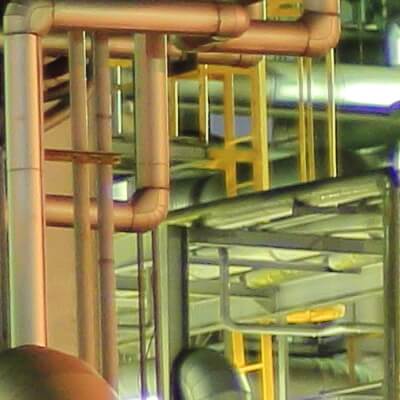f/8: Capturing the Details of Buildings and Structures
If you want to take pictures of large structures that are a slight distance away, such as factories and buildings, we recommend using f/8. The image that you get will have minimal out-of-focus areas, with details sharply depicted throughout the entire frame. It’s also worth noting that f/8 is also an excellent choice for shooting natural landscapes and street photography. (Reported by: Teppei Kohno)

f/8, 13 sec, ISO 400
f/8 keeps structural details sharp—as long as you are not too far away!
When photographing streets, buildings and factories, what you want is to depict concrete and metal textures in a clear and sharp manner. At aperture setting f/8, as long as your subject is not too near (for example, at least around 8.25m* away on the EF50mm f/1.8 STM and an APS-C sensor camera, roughly equivalent to a building across a two-lane road), the depth-of-field at f/8 should be enough to keep the image sharp all the way to infinity, and even capture the texture of the metallic areas accurately so that the overall image looks true to life.
* Calculated based on half the hyperfocal distance. The hyperfocal distance is the minimum focusing distance that provides maximum depth-of-field and depends on aperture setting, camera sensor size and focal length. Try out this depth-of-field calculator to see the results for another focal length. Generally, hyperfocal distance also increases with the focal length.
Going too narrow can backfire
If the subject is very far away, narrowing the aperture any more than f/8 will not make much of a difference to how sharp the image appears. In fact, over-narrowing the aperture may even cause the image to lose its sharpness due to a phenomenon called "diffraction", where light waves entering the lens are blocked by the aperture blades and forced to bend, resulting in an image that is less crisp.
If you feel that the f/8 depth-of-field is not large enough, you can narrow the aperture slightly, but be conservative about your adjustments. Most photographers will try not to go beyond f/11 unless they have a good reason, such as if they want to create a starburst effect and the image quality is of secondary priority.
The three images below, shot at f/2, f/8, and f/22 respectively, show how aperture affects sharpness.
f/2

f/2, 1/4 sec, ISO 800

At f/2, the lines appear blurred ("soft") due to the shallow depth-of-field. The purple discolouration (colour fringing) in the image are a sign of axial chromatic aberration, which is more likely to occur in images shot at wider apertures.
f/8

f/8, 4 sec, ISO 800

At f/8, the lines appear sharper and crisper.
f/22

f/22, 30 sec, ISO 800

At f/22, there are beautiful starbursts from the lights. However, the lines appear soft due to narrow aperture diffraction.
Here is a GIF of the close-ups for comparison. Do you see the difference especially in the outlines?

Tip: If your scene has elements that are slightly further away, you will need to use deep focus technique. Try f/11 for a start.
Bonus technique: Enhance the metallic feel with 'White Balance -Tungsten Light’
When the lighting around your subject has a unique colour cast, such as in the example at the top, it could also be fun to play around with the White Balance (WB) settings. You may even end up creating a photo that has a different visual effect from the actual scene. For nightscape photos like this one, we recommend the ‘Tungsten Light’ setting. This imparts a bluish hue, transforming the mechanical-looking factory nightscape into one with cool, surreal feel.

f/8, 13 sec, ISO 250
WB-Auto: This has a somewhat surreal look, but there’s no uniqueness to it.

f/8, 13 sec, ISO 250
WB-Tungsten Light: A futuristic feel. The hue contributes to the construction of the atmosphere.
--
Not sure how to change your aperture settings? Click here for step-by-step instructions
---
To learn more about white balance and how to customise it, check out:
White Balance Basics to Achieve Your Desired Colour Tone
How to Render Colours with the White Balance Correction Function
For more tips on photographing buildings and architecture, check out:
Composition Tip: Adding Life to Building and Factory Photographs
Pro Tips for Improving Your Street-level Architecture Shots
Receive the latest update on photography news, tips and tricks.
Be part of the SNAPSHOT Community.
Sign Up Now!About the Author
Born in Tokyo in 1976, Kohno graduated with a Social Work degree from the Department of Sociology of Meiji Gakuin University, and apprenticed with photographer Masato Terauchi. He contributed to the first issue of photography magazine PHaT PHOTO and became an independent photographer after that, in 2003. The author of many books, Kohno not only shoots all sorts of commercial photographs, but also writes prolifically for camera and other magazines.

































